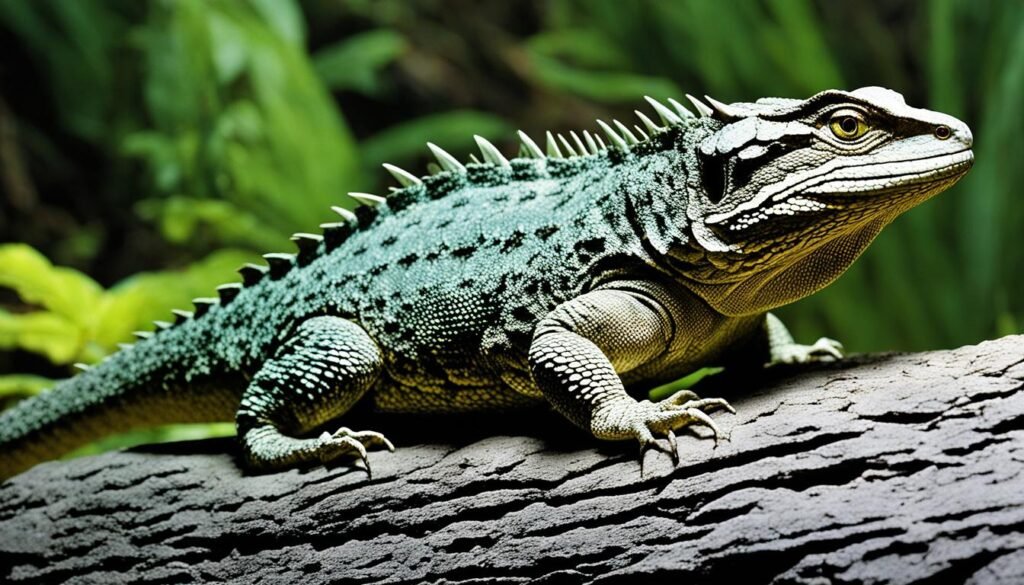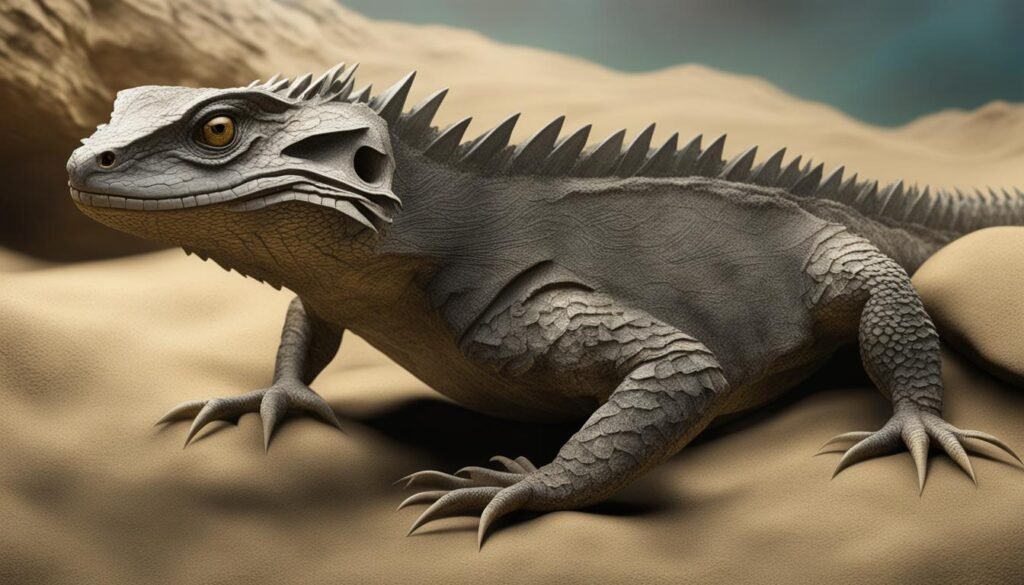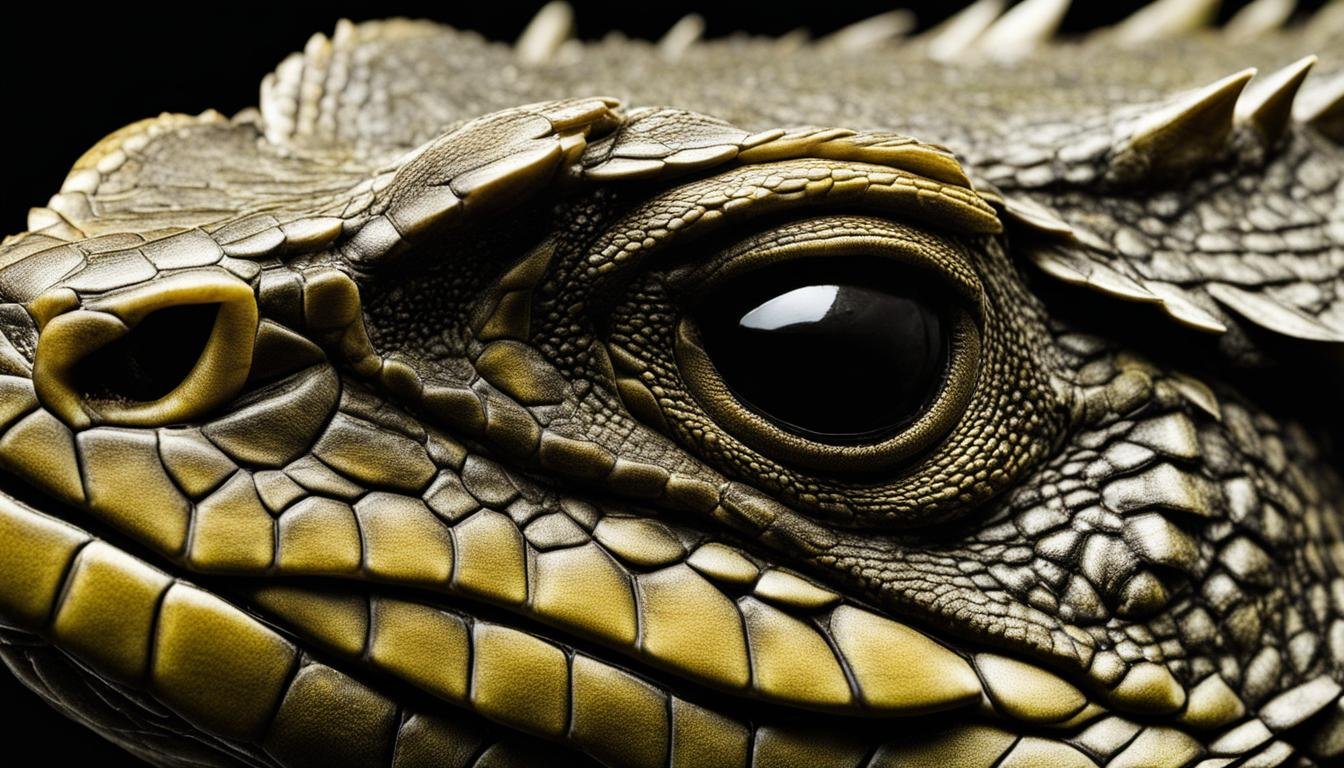Did you know that the tuatara, a unique reptile native to New Zealand, has remained virtually unchanged for a staggering 190 million years? This ancient creature, belonging to the order Rhynchocephalia, is a living fossil that holds a wealth of secrets waiting to be unveiled. From its distinctive biology and reproduction to its cultural significance and conservation efforts, the tuatara is a fascinating subject that captivates researchers and wildlife enthusiasts alike.
Key Takeaways:
- The tuatara is an ancient reptile that has remained largely unchanged for 190 million years.
- Tuatara exhibits unique physical features, including a tripartite jaw structure and a parietal eye.
- The reptile has a slow reproductive cycle, with females having a long incubation period and juveniles taking several years to reach sexual maturity.
- Conservation efforts are crucial for the tuatara’s survival, given the threat of invasive predators and habitat loss.
- Tuatara holds cultural significance in Māori culture and plays a vital role in educational programs that promote wildlife conservation and biodiversity preservation.
The Unique Biology of Tuatara
Tuataras, a unique group of reptiles, possess several distinguishing physical features that set them apart from other reptilian species. These adaptations enable them to thrive in their natural habitats and contribute to their survival. Let’s explore some of the fascinating characteristics of tuataras:
Tripartite Jaw Structure
Tuataras possess a tripartite jaw structure, making their jaws distinct from those of other reptiles. Both their upper and lower jaws have fused projections, creating a specialized mechanism for efficient biting and chewing. This adaptation allows tuataras to consume a variety of prey, including insects, small vertebrates, and even carrion, contributing to their diverse diet.
Parietal Eye
One of the most intriguing features of tuataras is their parietal eye, located on top of their heads. The parietal eye is a translucent crown scale that is sensitive to light changes but does not possess visual capabilities. While its exact function is not fully understood, it is believed to help regulate circadian rhythms, allowing tuataras to synchronize their activities with environmental light patterns.
Behavioral Adaptations
Tuataras are ectothermic, meaning their body temperature depends on the external environment. To cope with a wide range of temperatures, tuataras have developed various behavioral modifications. They are primarily nocturnal and crepuscular, meaning they are most active during the cooler parts of the day, when the risk of overheating is reduced. This behavior allows tuataras to optimize their foraging and hunting activities while minimizing the energy expended on thermoregulation.
In addition to their activity patterns, tuataras exhibit other behavioral adaptations to adapt to changing environmental conditions. They can lower their metabolic rates, enabling them to conserve energy during periods of limited food availability. This adaptability helps them survive in their native habitats, which can sometimes be challenging environments.
In conclusion, tuataras possess unique physical features and behavioral adaptations that make them intriguing subjects of scientific study. Their tripartite jaw structure, parietal eye, and behavioral modifications highlight their evolutionary success and their ability to thrive in diverse environments.
Reproduction and Life Cycle of Tuatara
Tuataras have a unique reproductive cycle, characterized by infrequent mating and a lengthy incubation period. The slow reproductive process of tuataras ensures the survival and adaptation of this ancient reptile species. Let’s explore the fascinating details of their reproduction and life cycle.
Mating Frequency
Tuataras engage in mating once every two to five years, a relatively low frequency compared to other reptiles. This infrequency is believed to be associated with their slow metabolism and the need to conserve energy. Consequently, tuataras invest substantial time and resources in each reproductive event, ensuring the production of viable offspring.
Incubation Period
One of the most remarkable aspects of tuatara reproduction is the lengthy incubation period. Female tuataras lay their eggs in burrows or natural crevices, providing a safe and warm environment for development. The incubation period typically lasts between 12 to 15 months, significantly longer than most reptiles. This extended incubation allows the embryos to develop fully and increases their chances of survival once hatched.
Slow Metabolism and Sexual Maturity
Tuatara’s slow metabolism plays a crucial role in their reproductive cycle. Their ability to maintain good health and energy levels, even during periods of scarcity, allows them to endure the long incubation and maturation process. Juvenile tuataras take several years to reach sexual maturity, further contributing to their slow reproductive cycle. This delayed sexual maturity ensures that tuataras possess the necessary physical and physiological traits to successfully reproduce. It also enhances their ability to adapt and persist in changing environmental conditions.
| Tuatara Reproduction Facts | Details |
|---|---|
| Mating Frequency | Once every two to five years |
| Incubation Period | 12 to 15 months |
| Metabolism | Slow and efficient |
| Sexual Maturity | Reached after several years |
Conservation Efforts for Tuatara
Tuatara conservation efforts are of utmost importance to ensure the survival of these unique reptiles in the face of invasive predators and habitat loss. Conservation organizations and breeding programs are working tirelessly to protect tuataras and promote their long-term viability. Furthermore, the establishment of predator-free offshore islands provides a safe haven for tuataras to thrive.
Invasive predators pose a significant threat to tuataras, as they often prey upon their eggs, hatchlings, and even adult individuals. These introduced species, such as rats, mice, and stoats, can decimate tuatara populations if left unchecked. To combat this, conservation organizations implement targeted predator control measures, including trapping, poisoning, and habitat modification, to reduce the impact of invasive species on tuataras.
Habitat loss is another major concern for tuatara populations. Human activities, such as urban development, agriculture, and deforestation, encroach upon the natural habitats of tuataras, fragmenting their populations and limiting their access to essential resources. Conservation efforts focus on preserving and restoring tuatara habitats, including protected reserves and sanctuaries, to ensure the long-term survival of these reptiles.
Breeding programs also play a crucial role in tuatara conservation. These programs involve captive breeding and reintroduction initiatives to boost the population size and genetic diversity of tuataras. By carefully managing captive populations and facilitating controlled breeding, these programs help mitigate the effects of habitat loss and invasive predators on wild tuatara populations.
Conservation Efforts for Tuatara
| Conservation Efforts | Description |
|---|---|
| Predator Control | Implementing measures to control invasive predators and minimize their impact on tuatara populations, including trapping, poisoning, and habitat modification. |
| Habitat Preservation | Preserving and restoring tuatara habitats through protected reserves and sanctuaries, ensuring their availability of essential resources. |
| Breeding Programs | Captive breeding and reintroduction initiatives aimed at increasing tuatara population size and genetic diversity. |
Tuatara’s Cultural Significance
In Māori culture, tuataras hold deep-rooted cultural significance. They are revered as treasured indigenous fauna, known as taonga, and are intertwined with the myths and legends of New Zealand. Tuataras embody the natural heritage of the country and symbolize its unique biodiversity.
The Māori people have a rich oral tradition that includes stories and legends featuring the tuatara. These tales depict the tuatara as guardians of knowledge, wisdom, and protection. According to Māori mythology, the tuatara played a crucial role in the creation of mankind.
The tuatara’s representation in Māori culture reflects the deep connection the indigenous people have with New Zealand’s natural environment. It highlights the respect and admiration for the country’s unique fauna and the role they play in shaping Māori identity and heritage.
The tuatara’s cultural significance extends beyond Māori mythology. It is recognized as an emblem of New Zealand’s natural heritage and serves as a symbol of the country’s commitment to conservation and biodiversity preservation.
| Key Points: |
|---|
| Tuataras hold cultural significance in Māori culture and are considered treasured indigenous fauna. |
| They are featured in Māori myths and legends, symbolizing knowledge, wisdom, and protection. |
| The tuatara represents New Zealand’s natural heritage and the country’s commitment to conservation. |
Tuatara in Education
Education plays a vital role in nurturing a sense of responsibility for wildlife conservation and raising awareness about the delicate balance within ecosystems. By introducing tuataras to students, we provide them with a unique opportunity to deepen their knowledge of these fascinating reptiles and inspire their active participation in protecting endangered species and their habitats.
The study of tuataras contributes not only to their preservation but also to a broader understanding of biodiversity and the intricate web of life within ecosystems. Students gain valuable insights into the importance of maintaining healthy ecosystems and the impact of human activities on wildlife and the environment.
The Benefits of Tuatara Education
- Knowledge enrichment: Exploring tuataras as living fossils and ancient reptiles enhances students’ understanding of the evolution of life on Earth and the diversity of species that have inhabited our planet.
- Environmental awareness: Learning about the challenges tuataras face, such as habitat loss and conservation efforts, cultivates a sense of responsibility and encourages students to become advocates for change and environmental stewardship.
- Conservation education: Educating students about tuataras provides a platform for discussing broader conservation issues, instilling a sense of empathy, inspiring action to protect our natural heritage, and promoting sustainable practices.
- Scientific inquiry and critical thinking: Studying tuataras fosters skills in scientific observation, data analysis, and critical thinking, encouraging students to ask questions, conduct research, and draw evidence-based conclusions.
Through tuatara education, we equip students with the knowledge, skills, and motivation necessary to become informed, responsible stewards of our planet and its diverse flora and fauna.
Overview of Tuatara Species
There are two species of tuatara found in New Zealand, namely Sphenodon punctatus and Sphenodon guntheri. The Sphenodon punctatus, commonly known as the Cook Strait tuatara, and Sphenodon guntheri, known as the Brothers Island tuatara, are both endemic to New Zealand. These fascinating reptiles are exclusively found on 30 offshore islands, making them a unique part of New Zealand’s biodiversity.
Tuatara’s Prehistoric Appearance

Tuataras possess a remarkable prehistoric appearance, reminiscent of somber iguanas. These reptiles have been dubbed as living fossils due to their striking resemblance to their ancient ancestors who roamed the Earth a staggering 190 million years ago. Their prehistoric features make them captivating subjects for studies in paleontology and evolutionary biology.
One of their distinctive characteristics is their reptilian countenance. Tuataras display a unique combination of reptilian attributes that transport us to an era long gone. Their rugged scales, ancient visage, and stoic demeanor evoke a sense of ancient splendor, providing us with a glimpse into the distant past.
The tuatara’s prehistoric appearance is a testament to their resilience and adaptability. Despite the passage of time, their physical form has remained relatively unchanged, a testament to their remarkable ability to withstand the test of time as a living fossil.
Embodying the spirit of ancient reptiles, tuataras serve as a bridge connecting our present world with an ancient era. The sight of these magnificent creatures transports us back in time, fostering a sense of awe and reverence for the evolutionary journey they have traversed over millions of years.
Tuatara’s Long Lifespan
Tuataras are remarkable reptiles renowned for their extraordinary lifespan. These ancient creatures have the ability to live for over a century, making them one of the longest-lived reptile species on the planet. One of the contributing factors to their remarkable longevity is their slow-growing nature. Tuataras have a slow growth rate compared to other reptiles, which allows them to achieve their extended lifespan.
Their slow growth rate is a result of their unique metabolism and physiological adaptations. Tuataras possess a remarkable ability to conserve energy, enabling them to survive in environments with limited resources. This slow-growing characteristic allows tuataras to allocate energy efficiently, ensuring their survival for an extended period.
Due to their longevity and slow growth, tuataras experience gradual changes throughout their lifecycle. They take several years to reach sexual maturity, contributing to their extended lifespan. This deliberate pace of development is a testament to the evolutionary success of these reptiles and their ability to adapt and thrive in their unique New Zealand habitat.
The tuatara’s long lifespan provides researchers and conservationists with a valuable perspective on the evolution and biology of these ancient reptiles. By studying the tuatara’s lifespan and its underlying mechanisms, scientists can gain insights into the factors that contribute to the longevity of life forms and potentially unlock new avenues for understanding and improving human longevity.
Fossils and Tuatara’s Evolutionary Enigma

The tuatara and their ancient relatives, the Rhynchocephalians, present an intriguing evolutionary enigma. The fossil record of these unique reptiles is sparse, leaving many unanswered questions about their evolutionary history.
During the Mesozoic Era, Rhynchocephalians were once widespread, thriving alongside dinosaurs. However, over time, they declined in numbers and diversity, with the tuatara being the sole survivor of this ancient group.
Tuatara fossils provide crucial insights into the evolutionary trajectory and adaptations of these fascinating reptiles. By studying their remains, scientists can unravel the mysteries of their lineage and understand how they have persisted remarkably unchanged for millions of years.
Comparative Table: Tuatara Fossils vs. Rhynchocephalians
| Tuatara Fossils | Rhynchocephalians |
|---|---|
| Limited in number | Abundant fossil record |
| Provide insights into tuatara’s evolution | Offer a glimpse into the diversity of the group |
| Help understand tuatara’s adaptations | Reveal variations and adaptations in different species |
Tuatara’s Future and Environmental Awareness
Protecting tuataras and their habitats is crucial for their future survival. As we move towards a more sustainable future, increasing environmental awareness is key to preserving the biodiversity of our planet. By prioritizing habitat preservation and conservation efforts, we can create a healthier and more balanced ecosystem for tuataras and other species to thrive.
Biodiversity plays a vital role in maintaining the stability of ecosystems, and tuatara, as ancient reptiles, are an integral part of the intricate web of life. Their unique characteristics and adaptations contribute to the overall resilience and health of the environment. By preserving the habitats where tuataras reside, we are not only ensuring their survival but also protecting the biodiversity of the entire ecosystem.
Environmental awareness is crucial in promoting the conservation of tuataras and their habitats. Through education and outreach programs, we can raise awareness about the importance of biodiversity conservation and the role each individual can play in safeguarding our natural heritage. By fostering a sense of environmental responsibility, we empower future generations to actively participate in habitat preservation and biodiversity conservation initiatives.
Benefits of Tuatara Conservation
Tuatara conservation efforts have far-reaching benefits. By preserving tuataras and their habitats, we ensure the continuation of a unique species that has witnessed the passage of time for millions of years. Protecting tuataras also helps preserve the cultural significance they hold in Māori culture, recognizing them as treasured symbols of New Zealand’s natural heritage.
Furthermore, tuatara conservation directly contributes to the overall health and resilience of ecosystems. As top predators, tuataras help control populations of prey species, maintaining a balanced ecological system. Their presence supports the intricate connections between species and ensures the proper functioning of food chains and energy flow.
Steps Towards a Sustainable Future
To secure a bright future for tuataras, we must prioritize habitat preservation and take proactive measures to mitigate the threats they face. This involves identifying and addressing factors such as habitat destruction, climate change, invasive species, and pollution that adversely affect tuatara populations.
Conservation organizations play a pivotal role in implementing strategies that protect tuataras and their habitats. By partnering with local communities, government agencies, and research institutions, these organizations can raise awareness, conduct scientific research, and advocate for policies that support biodiversity conservation.
The Power of Collective Action
Preserving tuataras and their habitats requires collective action and collaboration. By engaging individuals, communities, and organizations, we can create a unified front to address the environmental challenges that threaten the future of tuataras and other endangered species.
Together, we can make a difference. By promoting environmental awareness, supporting habitat preservation initiatives, and advocating for biodiversity conservation, we can ensure a sustainable future for tuataras and protect the delicate balance of our planet’s ecosystems.
Conclusion
Educating students about the tuatara, a unique reptile species native to New Zealand, is crucial for fostering a deeper understanding of their biology and conservation needs. By raising awareness about the tuatara and promoting wildlife conservation efforts, we can contribute to the preservation of New Zealand’s cultural and natural heritage.
The tuatara’s ancient lineage and unchanged biology for millions of years make it a living testament to the biodiversity and evolutionary history of our planet. Through educational initiatives, we can inspire future generations to appreciate and protect these ancient reptiles, ensuring their survival and the preservation of their habitats.
Conservation efforts for tuataras are essential due to the threats posed by invasive predators and habitat loss. By supporting organizations that focus on tuatara conservation and participating in breeding programs, we can actively contribute to the protection and restoration of their populations. Additionally, the establishment of predator-free offshore islands provides a safe haven for tuataras, allowing them to thrive in their natural environment.
As we work towards preserving the tuatara and its unique lineage, we recognize the broader significance of biodiversity and its role in maintaining healthy ecosystems. By valuing and protecting the tuatara, we safeguard not only a fascinating reptile species but also contribute to the conservation of New Zealand’s rich natural heritage for future generations to appreciate and cherish.


3 thoughts on “Tuatara: Unveiling Ancient Reptile Mysteries”